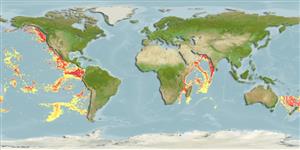Pycnogonida |
Pantopoda |
Phoxichilidiidae
Environment: milieu / climate zone / depth range / distribution range
Ecology
Benthic; depth range 1510 - 3358 m (Ref. 9). Tropical
Indo-Pacific.
Length at first maturity / Size / Weight / Age
Maturity: Lm ? range ? - ? cm Max length : 1.9 cm LS male/unsexed; (Ref. 9)
Leg span about 1.9 cm. Trunk and lateral processes robust. Neck widened just anterior to first lateral processes, palp buds visible in dorsal view. Ocular tubercle at anterior rim of cephalic segment; low, rounded eyes not prominent, sometimes difficult to see. Proboscis long, slightly swollen and wider at midpoint than distally. Abdomen very long, slender. Chelifores long, scapes 2 segmented, second segment with few long setae. Chelae large, palm little longer than wide, fingers very long, at slight angle to palm, immovable finger with few short setae at base, neither with teeth. Oviger second, fourth and fifth segments almost equal in length, strigilis with many setae longer than their segments. Legs moderately long, major segments with many long setae longer than segment diameters, second tibiae the longest segments. Tarsus very short, with one long slender sole spine, several sole setae. Propodus very short, not curved, heel armed with single huge broad spine, one smaller distal spine, and several tiny sole spines. Claw very long, about the length of propodus, auxiliaries tiny, slightly longer than claw basal diameter. Ventral cement gland tube short, about half femoral diameter (Ref. 9).
Life cycle and mating behavior
Maturity | Reproduction | Spawning | Eggs | Fecundity | Larvae
Members of the class Pycnogonida are gonochoric and sexually dimorphic. During copulation, male usually suspends itself beneath the female. Fertilization occurs as the eggs leave the female's ovigers. Males brood the egg masses until they hatch. Life cycle: Eggs hatch into protonymphon larva then to adults.
Child, C.A. 1998. (Ref. 9)
IUCN Red List Status (Ref. 130435)
CITES status (Ref. 108899)
Not Evaluated
Not Evaluated
Threat to humans
Human uses
| FishSource |
Tools
More information
Age/SizeGrowthLength-weightLength-lengthMorphologyLarvaeAbundance
Internet sources
Estimates based on models
Preferred temperature
(Ref.
115969): 1.9 - 4, mean 2.6 (based on 491 cells).
Vulnerability
Low vulnerability (10 of 100).
Price category
Unknown.
